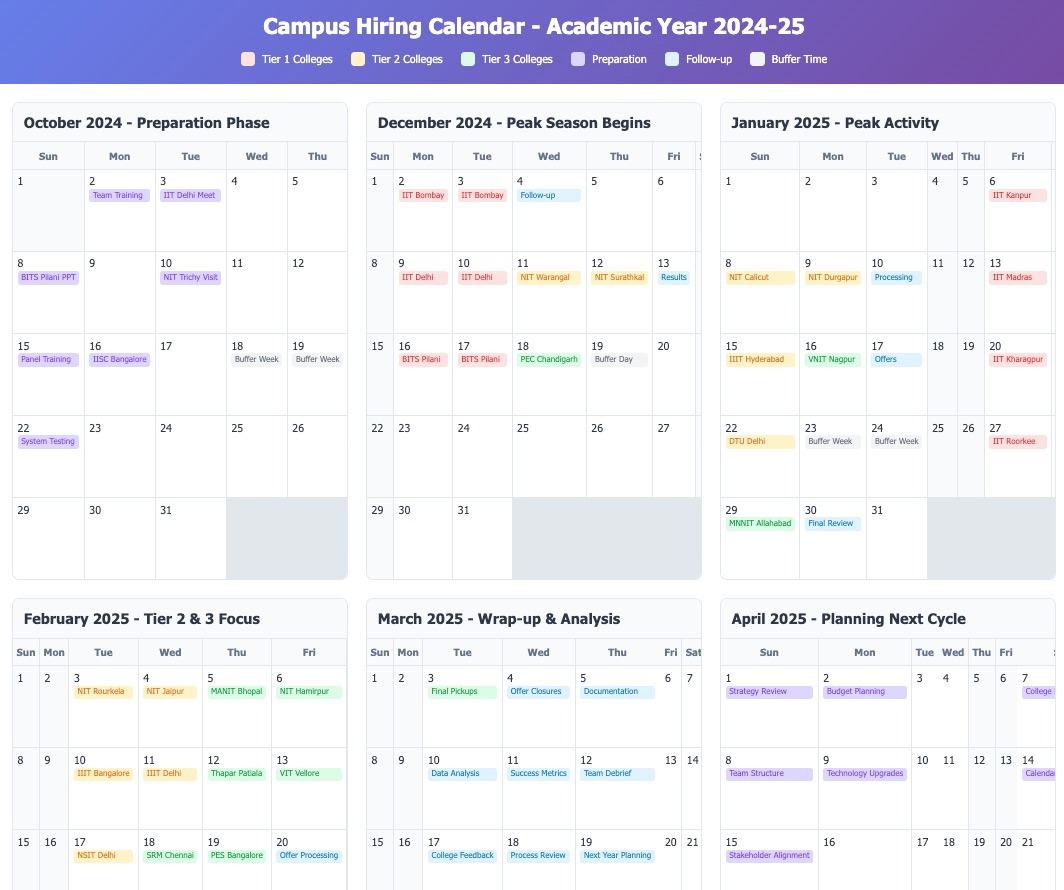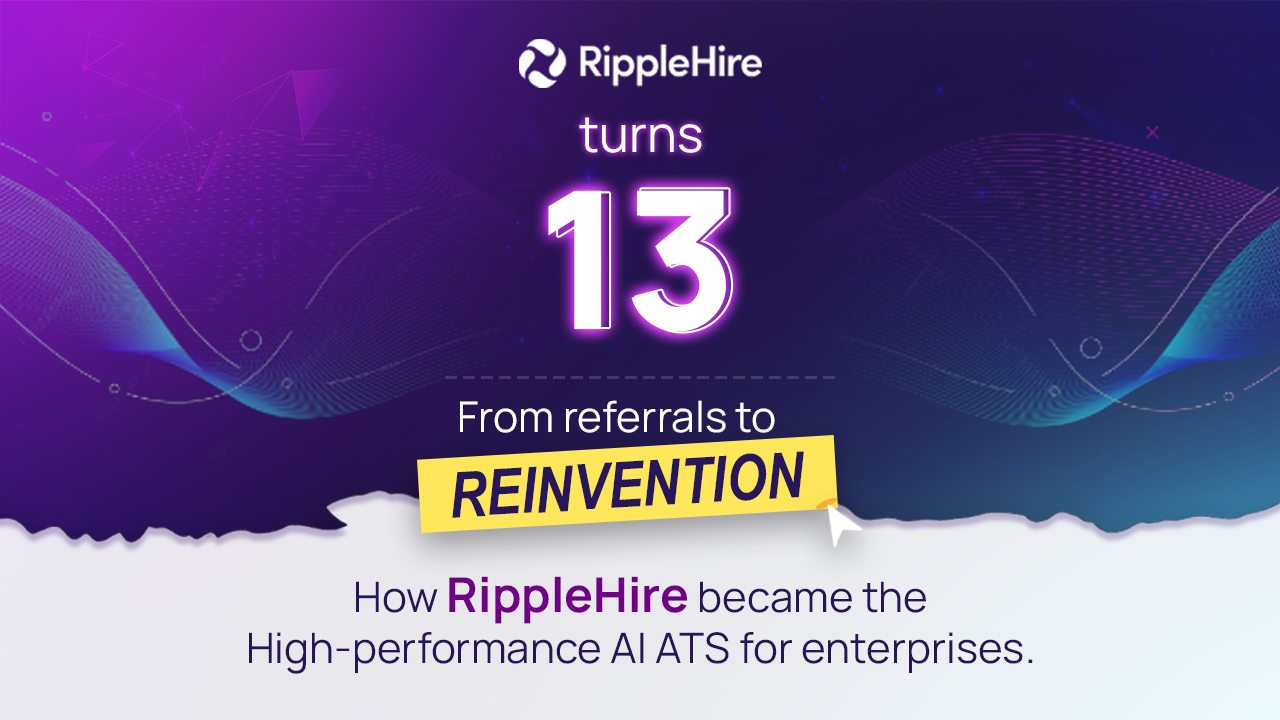Building an effective campus hiring calendar for large-scale talent acquisition
Campus recruitment season hits like a tsunami. Every college wraps up its final semester within the same 2-3 month window, flooding the market with graduates simultaneously. Your recruitment team faces an impossible choice: either scramble to cover 50+ campuses with limited resources, or miss out on top talent to competitors who planned better.
The traditional approach of treating campus hiring as a "seasonal sprint" burns out teams and compromises candidate quality. What you need is a calendars that distribute recruitment activities, optimize team utilization, and maintain a consistent candidate experience even during peak chaos.
This guide reveals how to design a campus hiring calendar that manages volume intelligently. We'll explore resource allocation strategies, timeline staggering techniques, and coordination frameworks that turn recruitment season from a nightmare into a well-orchestrated operation that delivers results without destroying your team.
Tips to build your campus hiring calendar
Creating an effective campus hiring calendar requires reverse engineering from your business goals rather than following university schedules. Most enterprises make the mistake of reacting to college placement cycles instead of proactively designing their recruitment timeline.

Start with your hiring targets and work backwards
Begin by analyzing your actual hiring needs across different business units. Engineering teams might need fresh graduates for Q1 projects, while sales divisions prefer candidates starting in Q3 to align with annual planning cycles. Map these requirements against a 12-month timeline to identify your true demand patterns.
Document headcount requirements by department, seniority level, and preferred joining dates. This data becomes your foundation for calendar planning. Many organizations discover their actual hiring needs don't align with traditional campus placement seasons, creating opportunities for strategic timing.
Map college placement schedules across target institutions
Research placement calendars for your priority colleges over the past three years. Engineering colleges typically conduct placements between December and March, while management institutes follow different timelines. B-schools often run two cycles - summer internships (October-December) and final placements (January-March).
Create a master spreadsheet listing each target college, their placement dates, application deadlines, and historical hiring volumes. This visibility helps identify potential conflicts and resource crunches before they become problems.
Identify resource bottlenecks and capacity constraints
Assess your recruitment team's bandwidth realistically. Calculate how many colleges one recruiter can effectively handle simultaneously, factoring in travel time, interview coordination, and candidate follow-up. Most enterprises underestimate the administrative overhead of campus recruitment.
Account for senior stakeholder availability during peak season. Business leaders get overwhelmed when every college visit requires their participation in the same month. Stagger high-priority campus visits to ensure adequate leadership involvement without burnout.
Geographic clustering for efficiency
Group colleges by geographic proximity to minimize travel time and costs. Plan regional weeks where your team covers 3-4 colleges within the same city or state. This clustering reduces logistical complexity and allows for emergency backup options.

Factor in travel recovery time between regions. Recruiters performing back-to-back campus visits across different cities deliver subpar experiences due to fatigue and jet lag.
Buffer time allocation strategy
Reserve 20% of your calendar for unexpected opportunities and last-minute changes. Colleges frequently shift their placement dates, and high-potential institutions might extend surprise invitations. Without buffer time, these opportunities become sources of stress rather than competitive advantages.
Schedule these buffer weeks strategically — one before peak season starts, one in the middle, and one toward the end. This spacing provides flexibility throughout the recruitment cycle without disrupting your core planning.
Multi-location calendar coordination
Managing campus recruitment across multiple offices requires sophisticated coordination to prevent resource conflicts and maximize efficiency. Most enterprises struggle with overlapping schedules and duplicate efforts when regional teams operate in silos.
Centralized vs regional calendar ownership
Centralized approach: A single national team manages the master calendar, assigning colleges to regional offices based on proximity and capacity. This prevents conflicts but may miss local market insights and relationship advantages.
Regional ownership model: Each office manages its territory independently with quarterly alignment meetings. Mumbai handles western colleges, Bangalore covers southern institutions, while Delhi focuses on northern regions. This approach leverages local relationships but requires stronger coordination protocols.
Resource sharing frameworks
- Cross-location interviewer deployment: Bangalore's technical experts can interview for Delhi positions via video calls during peak season
- Backup panel arrangements: When primary interviewers become unavailable, other locations provide immediate coverage without rescheduling campus visits
- Shared travel resources: Recruiters from multiple offices can coordinate visits to colleges in border regions like Pune or Hyderabad
Implement shared calendar systems with real-time visibility across all locations. Each office should see national recruitment activity to avoid scheduling conflicts and identify collaboration opportunities. Weekly coordination calls during peak season ensure alignment and quick issue resolution.
Buffer time allocation becomes critical when coordinating multiple locations. Reserve 15% of each regional calendar for supporting other offices during emergencies or high-priority requirements.
Smart enterprises create regional specialization - Bangalore focuses on engineering colleges, Mumbai handles management institutes, while Delhi covers government institutions. This specialization improves recruiter expertise and college relationships while maintaining calendar efficiency.
Common pitfalls to avoid when creating hiring calendar
1. The February pile-up trap
Most enterprises schedule 70% of their campus visits between January and February, creating an impossible resource crunch. Teams burn out, interview quality drops, and top candidates slip through cracks due to delayed feedback.
Smart companies distribute visits across October-March, using pre-placement activities in earlier months to build relationships. Start with brand building and hackathons in October-November, conduct technical assessments in December, and save final interviews for January-March.
This approach transforms the frantic placement season into a well-orchestrated hiring campaign that maintains quality while managing team workload effectively.
2. Ignoring college examination schedules
Placing campus visits during college semester exams guarantees poor student participation and frustrated placement officers. Universities typically conduct exams 2-3 weeks before placement activities begin, but dates vary significantly across institutions.
Create a master exam calendar for all target colleges during your annual planning phase. Buffer your recruitment schedule around these periods, especially for Tier 1 institutions where competition is fierce. Missing this detail means arriving at campuses with skeleton attendance, wasted travel costs, and damaged relationships with placement cells that explicitly communicated exam conflicts.
3. Last-minute interviewer changes
Business leaders frequently cancel interview commitments due to "urgent priorities," leaving junior recruiters to conduct senior-level assessments inappropriately. This destroys candidate experience and compromises hiring quality.
Secure written commitments from interview panels 60 days before campus visits, including backup arrangements. Train alternative interviewers in advance rather than scrambling during crises.
Create standardized interview guides so any trained panel member can maintain consistency. When cancellations happen, having prepared alternatives prevents campus visit postponements that disrupt your entire calendar and disappoint college partners.
Transform your campus hiring with intelligent automation
Building a strategic campus hiring calendar is just the foundation. The real challenge lies in executing this plan seamlessly across multiple locations while managing thousands of candidate interactions during peak season.
Modern enterprises are moving beyond spreadsheet-based calendar management to intelligent talent acquisition platforms. Advanced systems automatically detect scheduling conflicts, sync interview panels across locations, and provide real-time visibility into recruitment progress. AI-powered analytics optimize timing and resource allocation based on historical data patterns.
Smart automation handles the complexity while your team focuses on relationship building and candidate assessment. Automated candidate communication maintains engagement, fraud detection protects hiring quality, and seamless college portal integration eliminates manual data entry errors.
The most successful enterprises combine strategic planning with technology that scales effortlessly during peak recruitment season.
Book a demo with RippleHire to see how leading enterprises are automating their talent acquisition workflows.
Frequently Asked Questions
1. When should we start planning our campus hiring calendar for the next year?
Start planning your campus hiring calendar 6-9 months before recruitment season begins. Begin by analyzing your actual hiring needs across different business units and mapping them against a 12-month timeline to identify true demand patterns.
Research placement calendars for priority colleges over the past three years to understand their scheduling patterns and identify potential conflicts before they become problems.
2. How do we avoid the February pile-up trap during campus recruitment?
Distribute campus visits across October-March instead of cramming 70% into January-February. Use pre-placement activities in earlier months for brand building and hackathons, conduct technical assessments in December, and save final interviews for January-March.
This transforms frantic placement season into a well-orchestrated campaign that maintains quality while managing team workload effectively, preventing recruiter burnout and delayed candidate feedback.
3. What's the best way to coordinate campus hiring across multiple office locations?
Choose between centralized management (a single national team assigns colleges based on proximity) or regional ownership (each office manages its territory independently). Both require quarterly alignment meetings and shared calendar systems with real-time visibility.
Implement resource sharing frameworks like cross-location interviewer deployment via video calls and backup panel arrangements. Create regional specialization where possible - Bangalore for engineering, Mumbai for management institutes.
4. How much buffer time should we allocate in our campus hiring calendar?
Reserve 20% of your calendar for unexpected opportunities and last-minute changes. Colleges frequently shift placement dates, and high-potential institutions might extend surprise invitations without warning.
Schedule buffer weeks strategically - one before peak season, one in the middle, and one toward the end. This spacing provides flexibility throughout the recruitment cycle without disrupting core planning activities.
5. How do we handle interviewer availability during peak campus season?
Secure written commitments from interview panels 60 days before campus visits, including backup arrangements. Train alternative interviewers in advance rather than scrambling during last-minute cancellations.
Create standardized interview guides so any trained panel member can maintain consistency. Business leaders frequently cancel due to "urgent priorities," so having prepared alternatives prevents campus visit postponements that disrupt your entire calendar.
6. What's the biggest mistake companies make when creating campus hiring calendars?
Ignoring college examination schedules is a major mistake. Placing campus visits during semester exams guarantees poor student participation and frustrated placement officers, wasting travel costs and damaging relationships.
Create a master exam calendar for all target colleges during annual planning. Universities conduct exams 2-3 weeks before placements, but dates vary significantly across institutions, requiring careful coordination.
7. How should we group colleges geographically for maximum efficiency?
Group colleges by geographic proximity to minimize travel time and costs. Plan regional weeks covering 3-4 colleges within the same city or state, reducing logistical complexity and enabling emergency backup options.
Factor in travel recovery time between regions since recruiters performing back-to-back visits across different cities deliver subpar experiences due to fatigue. Allow adequate rest between distant locations.
8. What technology can help manage complex campus hiring calendars?
Modern talent acquisition platforms automatically detect scheduling conflicts, sync interview panels across locations, and provide real-time visibility into recruitment progress. AI-powered analytics optimize timing based on historical data patterns.
Advanced systems handle automated candidate communication, fraud detection, and seamless college portal integration while your team focuses on relationship building. This eliminates spreadsheet-based management and reduces manual coordination errors.















